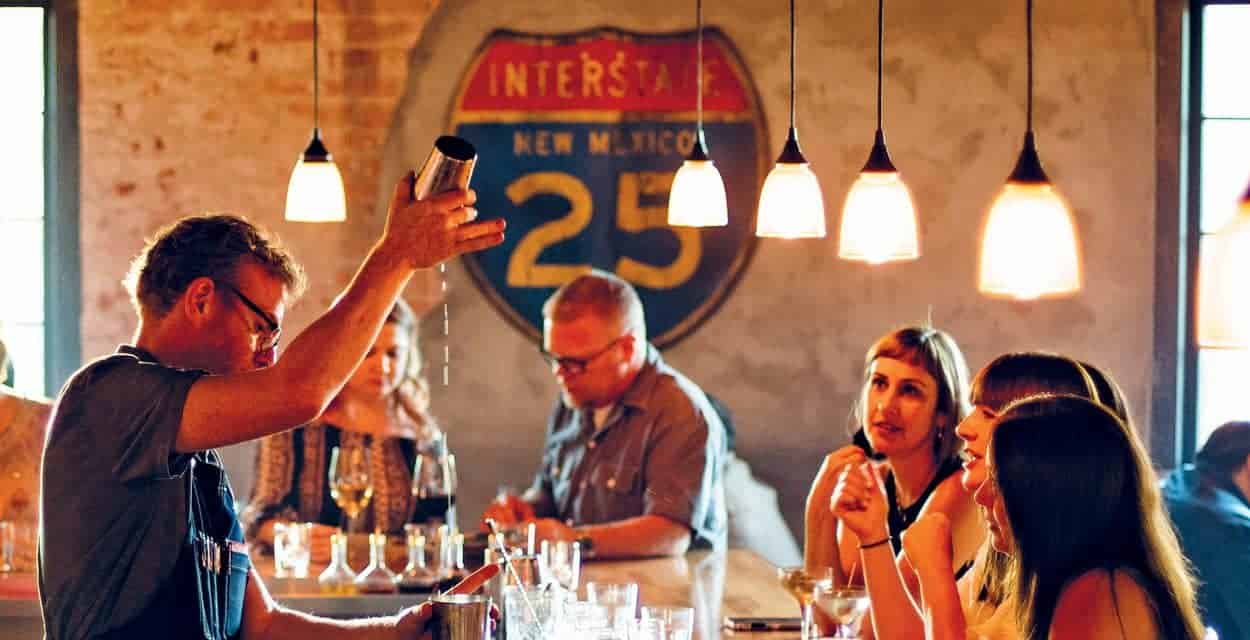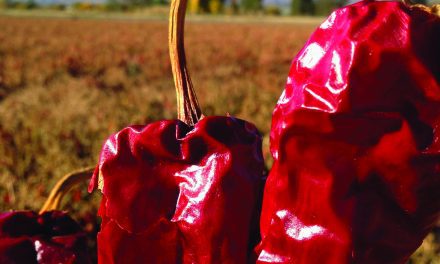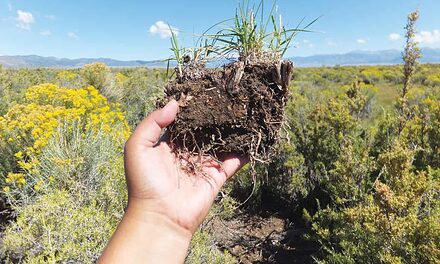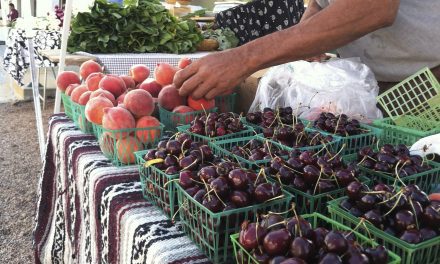As Many of Us Rush Back to Dining In, What Does
the “New Normal” Look Like for Restaurateurs?
By Ellie Duke · Photos by Douglas Merriam

Radish & Rye dining room.
To say 2020 was a difficult year is an almost laughable understatement. The restaurant industry was one of the hardest hit by the COVID-19 pandemic—the National Restaurant Association reported that 110,000 eateries closed in 2020, and those that did survive had to pivot quickly and creatively to operate under entirely different conditions than the ones one they had known before. Now, in the wake of a prolonged period of isolation, widespread access to vaccines signifies a newfound freedom. Over the last year and a half, many of us have reexamined our priorities and routines; we’ve experienced immense personal, professional, and global change. As the economy reopens, we have spent the recent months emerging into a new world.
One of the first freedoms that many were excited to exercise was, of course, dining in. After a year of to-go boxes and home-cooking experiments, we are eager to rush back to our favorite local eateries. But restaurants, like all public spaces, are finding their own version of a new normal. Uncertainty still hangs in the air, and staffing and sourcing continue to provide roadblocks for restaurant owners looking to return to their pre-pandemic pace. So, what does dining in look like in 2021?
“The new normal that we’ve adjusted to is [that] people are more in their own world,” says Camille Bremer, managing partner of Santa Fe’s Radish & Rye. “We have such a great bar, and such a great atmosphere where there [used to be] so much interaction happening between guests that don’t know each other. So that was a big change.” Bremer reflects that during the pandemic, people saw food more as a necessity than as an experience, and Radish & Rye prides itself on offering a unique, welcoming atmosphere, in addition to excellent food. But even though patrons might be keeping to themselves more, they are grateful to be able to once again experience dining in. “It’s amazing to see and to feel the support. . . . I can’t even tell you how many times a night I hear ‘I’m so glad you’re open, thank you so much for being here,’” Bremer adds.
While the lockdown was incredibly challenging for Radish & Rye, it did provide some opportunity to upgrade the space without cutting into the typical flow of operations. Bremer remodeled the bathrooms herself, “with lots of Googling how-tos,” and hung partitions that had been waiting in her garage for years. “It looks like it got a little facelift,” she observes. “I had the opportunity to do that without being rushed.”
Revel in Silver City also got some redecoration, thanks to a nationwide grant. “We applied for any and all aid,” says co-owner Kelsey Patterson, “and we were lucky to receive a little chunk of money that helped us finally afford a pergola awning top for our outdoor dining space. So we were finally able to make a major infrastructure update that we had been wanting to do for years.”
But for the folks at Revel, the pandemic provided more than time for a cosmetic upgrade. “We’ve done a lot of soul searching since this began that we hadn’t anticipated,” Patterson offers. And this reflection ultimately led to a significant change in business operations. “We’re going back to the core basic principles that got us started in this, which is honoring the local seasonal ingredients and having just beautifully plated elevated comfort food, just dialing back our model.” Starting in September, Revel will be open three days a week, by reservation only. “We can really set the pace of the evening and deliver the best possible product. Reduced hours, reduced volume, so we can do more of the fun, creative food that got us started,” says Patterson. Indeed, the pandemic impelled many of us to be more discerning—about our schedules, our expenditures, who we spent our time with. An increased attention to quality over quantity seems a fitting takeaway from this era of quarantine.

Radish & Rye upstairs bar.
Though Radish & Rye isn’t making quite as significant changes as Revel, Bremer echoes Patterson’s gratitude for the time off to reflect and reevaluate: “It was an opportunity to remember why we love this business, why we’re doing this. And also an opportunity to miss it. I think it renewed our mission, and also it renewed my passion for hospitality.” In light of all the change and challenge of the past year, she says it’s “more important than ever to welcome people into our space and make them feel at home.” In the fast-paced environment of restaurants, the chance to take a step back from the daily grind and renew your enthusiasm for your work is rare. A change of perspective has been, for many, one upside to an incredibly challenging time.
Joe Powdrell, co-owner of Mr. Powdrell’s Barbeque House in Albuquerque, credits their survival throughout the pandemic to the restaurant’s loyal customers. Powdrell’s has been operating in Albuquerque for over fifty years, and Powdrell estimates that 70 percent of their clientele are repeat customers. “They stayed with us,” he says, “in terms of buying from us and knowing what we were up against.” Powdrell’s has not yet reopened their indoor dining, due to staffing shortages. “I have a hard time telling [people] that our inside isn’t opened up,” Powdrell adds, “because they come not just as a customer, but as a friend.” As for when they might be able to reopen their in-person dining, Powdrell says he “really can’t predict it.”
Staffing shortages are a near-universal issue for restaurants in the wake of the COVID-19 pandemic. “Right now, our core staff is really burnt out,” says Patterson of Revel. “We just can’t find dependable extra help to fill in around the edges. People have decided to pursue other job opportunities.” The National Restaurant Association estimated that 2.5 million food service jobs were lost in 2020, and the majority of those positions have not been refilled. Nathan Mayes, executive chef and partner at Paloma in Santa Fe, reiterated Patterson’s theory about restaurant workers seeking new vocations. “It’s been tough getting enough staff to come back,” he said. “Some people that maybe wouldn’t have branched out to do something else maybe just had to because of necessity, whether that’s going back to school or whatever it may be.”
The demand is there: people are returning to restaurants in droves, and many establishments are sold out every night. But the pressure on the staff is intense, and many managers and owners don’t want to operate at a pace that will be too hard on their employees. “We’re not going to grow faster than what we can handle,” Bremer says of Radish & Rye. “We’re going to do it right, instead of hurrying and sacrificing the standard of our service.”
While sourcing food and other supplies were an issue for some, especially on a national level, Patterson feels that the pandemic reinforced her appreciation for her local network in the Silver City area. “We are a small, tight-knit community of restaurant people,” she remarks. For example, her farmers and vendors would keep her apprised of what would be available so she could plan her menu. It remains to be seen, but if national food-sourcing challenges prompt restaurants to look closer to home for their providers, that might be an additional upside of the pandemic.
Managers and front-of-house staff expressed their gratitude that, for the most part, restaurant goers have been gracious and respectful as they return to dining in. The Aspen Institute’s Food and Society Program has produced a set of guidelines to help restaurants navigate reopening safely (aspeninstitute.org/programs/food-and-society-program/safety-first/). Included was a Diner Code of Conduct, which highlights masking when required and, importantly, patience and kindness. While the risks for restaurant workers—and diners—is reduced by widespread access to vaccines, it is not zero, and patrons’ respect and appreciation of food service workers goes a long way in easing the transition back into normal operations.
While Powdrell credits his business’s resilience through the pandemic to its longevity, Mayes says he believes that Paloma survived, in part, because the restaurant is still in its adolescence. Having been open for four years, they are “lucky to be growing and to always be confronted with new sets of challenges. . . . We’re continually trying to figure out systems for our tiny space and make things more efficient; we’re constantly trying to adapt.” The constraints of the pandemic were simply a new hurdle to overcome, albeit a significant one. Mayes also used the pandemic as an opportunity to regain perspective and “get nitty-gritty with a lot of the details,” he reflects. “It was really going down to zero, hitting rock bottom, counting every dollar . . . and being thankful for the people who stuck with us through all of it.”
A feeling of optimism seems to pervade the restaurant industry today, despite ongoing challenges. “People bring life situations to your establishment, they bring funerals, new jobs, retirements,” says Powdrell. “We knew it already, but it became even more clear that food service and hospitality has a lot to do with that socialization. Distancing made that silver lining clear . . . absence makes the heart grow fonder.” Mayes agrees: “There’s a sense of camaraderie, there’s a sense of optimism.”
Alongside that optimism comes a new awareness that everything can change on a dime. For many restaurant owners, things are still in flux, and the most comfortable approach is to take things one day at a time. A reinvigorated love of hospitality; a deeper connection to our local network of purveyors, farmers, and general community; and increased flexibility all might be silver linings of an unexpected, difficult year, but the truth remains that the “new normal” may not become clear for a while, if ever. As Bremer articulates, “If we’ve learned anything from the last year, it’s that you never know.”
Radish & Rye, 505 Cerrillos, Santa Fe, radishandrye.com
Paloma, 401 S Guadalupe, Santa Fe, palomasantafe.com
Mr. Powdrell’s Barbeque House, 5209 Fourth St NW and 11301 Central, Albuquerque, bbqandsoulfoodabq.com
Revel, 304 N Bullard Street, Silver City, eatdrinkrevel.com

Ellie Duke
Ellie Duke is a writer and editor who previously worked as the Southwest US editor at Hyperallergic. She is a master’s candidate at Harvard Divinity School.













